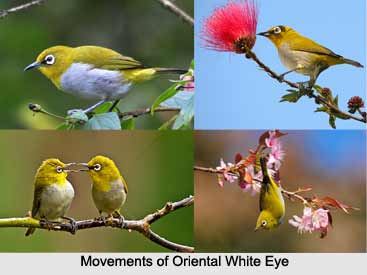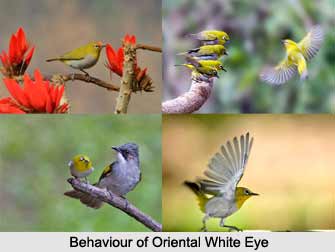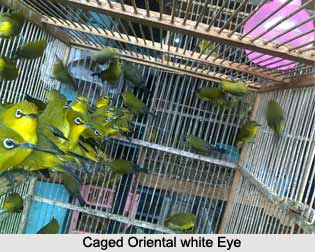 Oriental White-Eye is an Indian Bird that bears a scientific name "Zosterops palpebrosus" and it is a small passerine bird in the white-eye family.
Oriental White-Eye is an Indian Bird that bears a scientific name "Zosterops palpebrosus" and it is a small passerine bird in the white-eye family.
Concentration of Oriental White-Eye
Oriental White-Eye is a resident breeder in open woodland in tropical Asia, east from the Indian subcontinent to Southeast Asia, extending to Indonesia and Malaysia.
Forage of Oriental White-Eye
Oriental White-Eye forages in small groups, feeding on nectar and small insects. Oriental White-Eye is easily identified by the distinctive white eye-ring and overall yellowish upperparts. Several populations of this widespread species are named subspecies and some have distinctive variations in the extent and shades of yellows in their plumage
Structure of Oriental White-Eye
Oriental White-Eye is small with yellowish olive upper parts, a white eye ring, yellow throat and vent. The belly is whitish grey but may have yellow in some subspecies. The sexes look similar. The species is widespread and is part of a super species complex that includes Zosterops japonicus, Zosterops meyeni and possibly others. The taxonomy of the group is still unclear with some island populations being distinctive while some subspecies are not well supported. The population from Flores, Indonesia for instance is found closer to the pale white-eye. The family itself is now questioned since they are nested along with the Stachyris babblers.
Classes of Oriental White-Eye
 At about eleven subspecies of Oriental White-Eye are well recognised. These include the nominate form (type locality West Bengal which is found from Oman and Arabia, Afghanistan, northern India and extends into China and northern Myanmar). The population in the Western Ghats Mountain Range in India and hills of southern India like Niligiris Mountain Range placed in nilgiriensis while salimalii of the Eastern Ghats Mountain Range (Shevaroy, Chitteri, Seshachalam, Nallamalai) is sometimes subsumed into the nominate race.
At about eleven subspecies of Oriental White-Eye are well recognised. These include the nominate form (type locality West Bengal which is found from Oman and Arabia, Afghanistan, northern India and extends into China and northern Myanmar). The population in the Western Ghats Mountain Range in India and hills of southern India like Niligiris Mountain Range placed in nilgiriensis while salimalii of the Eastern Ghats Mountain Range (Shevaroy, Chitteri, Seshachalam, Nallamalai) is sometimes subsumed into the nominate race.
Races of Oriental White-Eye
In Sri Lanka, race egregia of Oriental White-Eye is smaller and has a brighter back and throat than the endemic Sri Lanka white-eye, Zosterops ceylonensis found in the central hills. The English and scientific names refer to the conspicuous ring of white feathers round the eyes, zosterops being Greek for `girdle-eye`.
Habitat of Oriental White-Eye
Oriental White-Eye is found in a wide range of habitats from scrub to moist forest. They sometimes occur on mangrove areas such as in the Karachi area and on islands they may lead a more insectivorous life. They are somewhat rare only in the drier desert regions of western part of India like Thar Desert in India.
Behaviour of Oriental White-Eye
Oriental White-Eye is sociable, forming flocks which only separate on the approach of the breeding season. They are highly arboreal and only rarely descend to the ground.
 Breeding Season of Oriental White-Eye
Breeding Season of Oriental White-Eye
The breeding season is from February to September but April is the peak breeding season and the compact cup nest is placed like a hammock on the fork of a branch. The nest is made of cobwebs, lichens and plant fibre.
Nests of Oriental White-Eye
The nest of Oriental White-Eye is built in about 4 days and the two pale blue eggs are laid within a couple of days of each other. The eggs hatch in about 10 days. Both sexes take care of brooding the chicks which fledge in about 10 days. Though mainly insectivorous, the Oriental White-Eye will also eat nectar and fruits of various kinds.
Call of Oriental White-Eye
Oriental White-Eye calls frequently as they forage and the usual contact call is a soft nasal cheer. They pollinate flower when they visit them for flower insects (such as thrips) and possibly nectar (questioned) that form their diet. The forehead is sometimes coloured by pollen leading to mistaken identifications. They have been observed bathing in dew accumulated on leaves. When nesting, they may mob palm squirrels but being small birds they are usually on the defensive. Their predators include bats (esp. Megaderma lyra) and birds such as the White-Throated Kingfisher. Endoparasitic Haemosporidia of the genus Haemoproteus and Dorisa have been isolated from the species although these rarely cause death.











